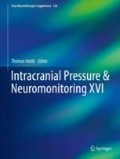Abstract
Objectives: Slow waves of intracranial pressure (ICP) are spontaneous oscillations with a frequency of 0.3–4 cycles/min. They are often associated with pathological conditions, following vasomotor activity in the cranial enclosure. This study quantifies the effects of general anaesthesia (GA) on the magnitude of B-waves compared with natural sleep and the conscious state.
Materials and methods: Four groups of 30 patients each were formed to assess the magnitude of slow waves. Group A and group B consisted of normal pressure hydrocephalus (NPH) patients, each undergoing cerebrospinal fluid (CSF) infusion studies, conscious and under GA respectively. Group C comprised conscious, naturally asleep hydrocephalic patients undergoing overnight ICP monitoring; group D, which included deeply sedated head injury patients monitored in the intensive care unit (ICU), was compared with group C.
Results: The average amplitude for group A patients was higher (0.23 ± 0.10 mmHg) than that of group B (0.15 ± 0.10 mmHg; p = 0.01). Overnight magnitude of slow waves was higher in group C (0.20 ± 0.13 mmHg) than in group D (0.11 ± 0.09 mmHg; p = 0.002).
Conclusion: Slow waves of ICP are suppressed by GA and deep sedation. When using slow waves in clinical decision-making, it is important to consider the patients’ level of consciousness to avoid incorrect therapeutic and management decisions.
References
Lalou DA, Czosnyka M, Donnelly J, Lavinio A, Pickard JD, Garnett M, Czosnyka Z. Influence of general anaesthesia on slow waves of intracranial pressure. Neurol Res. 2016;38(7):587–92.
Droste DW, Krauss JK. Simultaneous recording of cerebrospinal fluid pressure and middle cerebral artery blood flow velocity in patients with suspected symptomatic normal pressure hydrocephalus. J Neurol Neurosurg Psychiatry. 1993;56:75–792.
Lescot T, Naccache L, Bonnet MP, et al. The relationship of intracranial pressure Lundberg waves to electroencephalograph fluctuations in patients with severe head trauma. Acta Neurochir. 2005;147(2):125–9.
Lemaire JJ, Khalil T, Cervenansky F, et al. Slow pressure waves in the cranial enclosure. Acta Neurochir. 2002;144(3):243–54.
Kasprowicz M, Bergsneider M, Czosnyka M, et al. Association between ICP pulse waveform morphology and ICP B waves. Acta Neurochir Suppl. 2012;114:29–34. https://doi.org/10.1007/978-3-7091-0956-4_6.
Weerakkody RA, Czosnyka M, Zweifel C. Slow vasogenic fluctuations of intracranial pressure and cerebral near infrared spectroscopy—an observational study. Acta Neurochir. 2010;152(10):1763–9.
Swallow DM, Fellner N, Varsos GV, et al. Repeatability of cerebrospinal fluid constant rate infusion study. Acta Neurol Scand. 2014;130(2):131–8.
Girard F, Moumdjian R, Boudreault D, et al. The effect of sedation on intracranial pressure in patients with an intracranial space-occupying lesion: remifentanil versus propofol. Anesth Analg. 2009;109(1):194–8.
Fodale V, Schifilliti D, Praticò C, et al. Remifentanil and the brain. Acta Anaesthesiol Scand. 2008;52(3):319–26.
Pickard JD, Teasdale G, Matheson M, et al. Intraventricular pressure waves—the best predictive test for shunting in normal pressure hydrocephalus. In: Shulman K, Marmarou A, Miller JD, Becker DP, Hochwold GM, Brock M, editors. Intracranial pressure IV. Berlin: Springer-Verlag; 1980. p. 498–500.
Conflicts of interest statement
We declare that we have no conflicts of interest.
Author information
Authors and Affiliations
Corresponding author
Editor information
Editors and Affiliations
Rights and permissions
Copyright information
© 2018 Springer International Publishing AG
About this paper
Cite this paper
Lalou, D.A. et al. (2018). Are Slow Waves of Intracranial Pressure Suppressed by General Anaesthesia?. In: Heldt, T. (eds) Intracranial Pressure & Neuromonitoring XVI. Acta Neurochirurgica Supplement, vol 126. Springer, Cham. https://doi.org/10.1007/978-3-319-65798-1_27
Download citation
DOI: https://doi.org/10.1007/978-3-319-65798-1_27
Published:
Publisher Name: Springer, Cham
Print ISBN: 978-3-319-65797-4
Online ISBN: 978-3-319-65798-1
eBook Packages: MedicineMedicine (R0)

